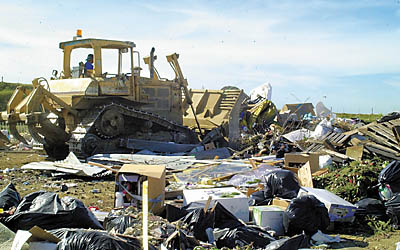
The transition into Hollister’s 3-month-old recycling program
has encountered some glitches, but the program has shown early
signs of success regarding the amount of garbage entering the
county landfill.
According to Mandy Rose, director of county Integrated Waste
Management, the program has already decreased the amount of waste
going into the John Smith Disposal Site Landfill by between 100 and
200 tons, an amount she called
”
significant.
”
The transition into Hollister’s 3-month-old recycling program has encountered some glitches, but the program has shown early signs of success regarding the amount of garbage entering the county landfill.
According to Mandy Rose, director of county Integrated Waste Management, the program has already decreased the amount of waste going into the John Smith Disposal Site Landfill by between 100 and 200 tons, an amount she called “significant.”
The city implemented the Single Stream Recycling Plan Dec. 16 to provide financial incentive for residents who use smaller garbage bins, complemented by larger recycling bins to accommodate most recyclable items into the one container.
However, officials have encountered mishaps with billing and distribution of bins.
“Let’s just say there have been some problems with implementation of the program,” Rose said.
Errors on customers’ first bill arose that officials have not entirely corrected, Rose said, as charges did not initially acknowledge the long-planned changes.
“They (Hollister Disposal) billed them exactly what they were being billed before,” she said. “Some people should have been charged more, and some should have saved.”
The city contracts refuse collection to county Integrated Waste Management and Hollister Disposal Waste Management.
Under the previous system, a monthly fee of $17.04 covered the cost for a 64-gallon garbage container. And if customers chose to recycle, the city charged an extra $5.
Now, if residents request a smaller garbage bin of 35 gallons and a 64-gallon recycling bin, the cost of both is supposed to be $14.50, a savings of almost $8 per month. The new rate for residents choosing to keep the larger 64-gallon garbage bin was bumped to $23.04.
For customers who opened their first statement, the false charges spelled confusion. For officials, it brought on frustration.
Rose said the problems are “just things that happen with transition,” and involved agencies are working to correct the mistakes. IWM, along with Hollister Disposal, will send a letter to customers during the next couple weeks to apologize and explain the situation.
“It just totally convoluted the change,” she said.
Additionally, about 900 customers who requested smaller garbage containers are still waiting for them, Rose said. Hollister Disposal underestimated the number needed and has ordered more.
Overall, Rose said 2,085 customers requested smaller garbage with larger recycling bins. About 100 customers ordered an even more environmental-friendly option, a 20-gallon garbage bin. The rest have kept the larger garbage bins, although she said some are likely evaluating whether they can fit all their garbage into the 35-gallon bin.
Success expected
Recyclable items generally take up relatively more volume and they weigh less. So a 100-ton to 200-ton reduction of garbage entering the landfill may not seem substantial, but it is, Rose said. However, until billing issues have been solved, she said IWM cannot gauge the true potential for the new program.
City officials instituted the plan because Hollister is not complying with 1989 legislation that, at the time, required a 50-percent reduction of waste by 2000. Hollister has since reduced its amount by 36 percent and has avoided substantial fines because of a “good-faith clause” in the measure, Rose said.
If municipalities demonstrate a concerted effort to reduce waste, they are exempt from penalties. Hollister’s current good faith extension expires in June 2004, Rose said.
In the long run, she was confidence the Single Stream Recycling Plan will guide the city in reaching the 50 percent reduction mark. John Delgado, district manager of Hollister Disposal Waste Management, expressed similar convictions. Affiliates, or “sister companies” of Hollister Disposal have experienced success with similar single stream programs, including San Jose, Watsonville and Santa Cruz.
Harry Samuelson, a Hollister resident for 42 years, pays the senior rate of about $11 per month and actively recycles, and said more should do the same.
“A lot of people probably don’t recycle because they just think it’s a hassle,” he said.
If Samuelson is correct, through the intended convenience of its young program, the city is attempting to change that attitude.
Hollister Public Works Director Clint Quilter said the city will soon work individually with businesses, both commercial and industrial, to find their most efficient methods of recycling.
“Everybody has a different process and different things to recycle,” Quilter said.









